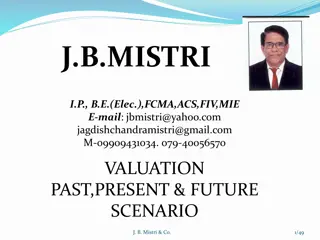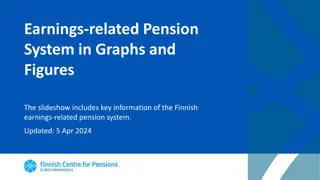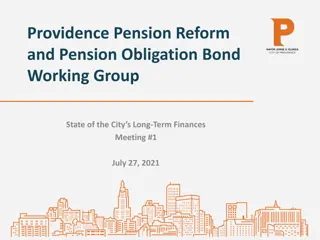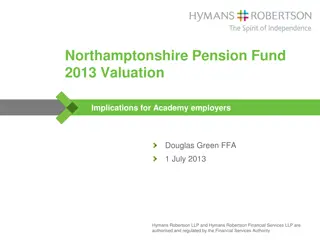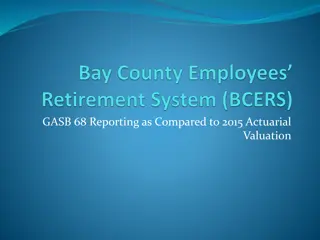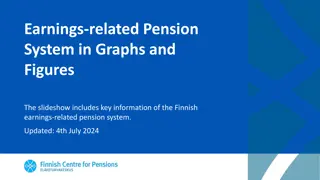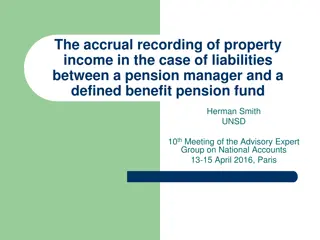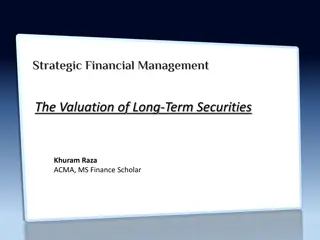Public Pension Plans: Valuation Controversy and Terminology Debate
Ongoing debate on valuing public pension obligations using the Market Pricing Model vs. Level Cost Model, with a focus on terminology like cost, liability, and obligation. Different perspectives on determining costs and liabilities based on financial economics and actuarial practices are discussed.
Download Presentation

Please find below an Image/Link to download the presentation.
The content on the website is provided AS IS for your information and personal use only. It may not be sold, licensed, or shared on other websites without obtaining consent from the author.If you encounter any issues during the download, it is possible that the publisher has removed the file from their server.
You are allowed to download the files provided on this website for personal or commercial use, subject to the condition that they are used lawfully. All files are the property of their respective owners.
The content on the website is provided AS IS for your information and personal use only. It may not be sold, licensed, or shared on other websites without obtaining consent from the author.
E N D
Presentation Transcript
NCPERS presents Financial Economics and the Management of Public Pension Plans: A Critical Response PAUL ANGELO, FSA, FCA, MAAA Senior Vice President & Actuary, Segal Consulting SHERRY S. CHAN, FSA, FCA, MAAA Chief Actuary, New York City Office of the Actuary September 27, 2017 5485051v3
The Market Pricing Controversy Ongoing controversy on how to value pension obligations for public sector pension plans The Level Cost Model Discount rate: expected return on assets Cost method: level cost based on projected benefits Based on established funding practices See Conference of Consulting Actuaries White Paper on Funding Policy The Market Pricing Model ( MV ABO , aka MVL, economic value ) Discount rate: market yields on low risk bonds (MV) Bonds with default risk comparable to the public pension promise Cost method: increasing cost based on accrued benefits (ABO) Based on financial economics (FE) Understanding the Valuation of Public Pension Liabilities: Expected Cost versus Market Price Society of Actuaries In the Public Interest newsletter, Jan. 2016 2
Terminology is part of the controversy Cost, liability, obligation and value: framework for discussion First, there s the (unquantified) concept of cost vs benefit The cost is the hurt on the taxpayer to provide a good thing (retirement security) to the employee Then, Cost is the quantified amount incurred in a period Liability is the Cost accrued to date (one determines the other) Obligation quantifies the promise to date (e.g., FASB s ABO) Depending on purpose, the Obligation value could be the Liability If so, then the periodic Cost is the change in the Obligation Value retains several meanings, both as verb and noun! 3
Terminology is part of the controversy Market Pricing proponents assert that the cost is that determined under the market pricing model Starts with MV ABO as liability (hence MVL) Then the periodic cost is MV ABO (change in MV ABO) In contrast, the Level Cost Model reverses the order Starts with an allocation of periodic Normal Costs (NC) with the same actuarial present value as the member s projected benefit Consistent with the periodic nature of the pension benefit Then the accrued liability is NC (sum of individual NCs) Under Actuarial Standards of Practice (ASOPs) 4 and 27, the basis for measurement of both cost and liability depends on the purpose of the measurement 4
Market Pricing and Public Plans Most discussion has been on whether public pension plans should disclose a Market Pricing type measure Actually three possible levels of application: Disclosure of MV ABO Accrued benefits at (default) risk-free discount rate Funding based on risk-free discount rate Even if invested in equities Avoid intergenerational risk sharing/transfer Investment only in bonds, not stocks See Bader/Gold The Case Against Stocks in Public Pension Funds Avoid increasing taxpayers equity risk exposure 5
Market Pricing and Public Plans Recent Society of Actuaries (SOA) webcast advocating full application of financial economics to public pension plans From SOA SI&PF Sept. 27, 2016 Webcast: What financial economics implies For better public pension financial management Current funding: 100% of normal cost (Traditional Unit Credit, at Solvency Value) Legacy funding: Same, as soon as practical Investments: Matched to liabilities Financial reporting: Marking current costs, assets and liabilities at Market Value Not always clear whether funding on FE basis is advocated even if plan is NOT investing on FE basis Our impression is they would say yes , plans should fund on Market Pricing model even if invested in more risky assets 6
What do the ASOPs say? Final ASOPs 4 and 27 stress purpose of the measurement ASOP 4: when measuring pension obligations and determining periodic costs or contributions ASOP 27: as a primary factor in selecting a discount rate Note Market-Consistent Measurements and market value assessments are included as a possible purpose ASOP 4 examples: contributions, accounting, settlement, market value assessments ASOP 27 examples: contributions, defeasement/settlement, market- consistent measurements So Market Pricing model is not just a type of measure it is itself a purpose of measurement 7
What is the Defining Purpose of the MV ABO? Financial Economics (FE) is the economics of financial markets Another terminology trap: Financial a synonym for Market Also use of value and worth to mean some particular valuation result So when FE proponents say economic value they mean financial economic value i.e., market replacement value (actual or theoretical) To the member, the economic value is whatever the pension will buy! Financial economists (FEs) develop models to understand, reproduce and predict the market pricing of traded securities Suppose a publically traded corporation sponsors a pension plan FEs need a value to represent the pension plan in their models That is the sole defining purpose of the MV ABO measurement All we know for sure about the MV ABO is that it is the appropriate representation of a Defined Benefit plan in a financial economic model of the sponsor (corporate or public) 8
Brief History of Market Pricing Model for Corporate Pension Plans Originally, ERISA minimum funding was only level-cost model IRC Sec. 412, from 1976 to 1987 Market pricing for corporate plans arrives in1987 Current Liability under OBRA 1987 for funding Also ABO under FAS 87 for expensing Clearly intended as a settlement measure of accrued benefits For funding, dual regime lasts for 20 years With RPA 1994, market pricing model starts to take over In 2003, the Great Controversy (SOA Vancouver) advocated strict market pricing for corporate pension funding Finally, PPA 2006 eliminates level cost funding for corporates Target Liability is a strict MV ABO (discount rate relaxed in 2012) Corporate Pension Actuary s Guide to FE published 9
Market focus: corporate vs public FE s market focus is appropriate for corporations A stock corporation exists solely to maximize its stock s market price Everything, including its pensions, must be considered as reducible to a market derived value and managed based on that market value. Public sector linkage to the market is less direct Agencies and pension plans participate in the markets The purpose of public agencies and pension plans cannot be reduced to a single market defined measure Corporations are of the market, while public agencies and plans are only in the market. FE principles do not incorporate this difference FE conclusions provide information about all stock corporations, not about all pension plans 10
Evaluating the Market Pricing Model as a Basis for Funding Public Pension Plans Consider what it means to use the Market Pricing model to measure the ongoing cost of a pension plan Focus on funding but discussion also applies to disclosure Start with the cost allocation method: Traditional Unit Credit (TUC) Accrued Liability = PV of accrued benefits (MV ABO) Normal Cost = Change in PV of accrued benefits ( MV ABO) Well known flaws in TUC/PVAB/ABO method for allocating costs Back-loaded cost allocation, sharply increasing individual normal costs Cost spikes at eligibility for retirement Demographically unstable aggregate normal cost Even for corporate plans, TUC was illegal for final pay plans Except as a settlement value 11
Normal Cost as a Percentage of Pay PVAB PVAB (ABO) (ABO) Cost % Entry Age Entry Age 25 35 45 55 65 Age
Evaluating Market Pricing: TUC/ABO Cost Method Under FE theory, the pension plan is a transfer of wealth Amount of annual wealth transfer is MV ABO MV ABO is part of members annual compensation For a career participant in later years of service, this MV ABO (i.e., TUC Normal Cost) should be the employees entire incremental compensation so no pay increases (or even pay) Source: GASB Financial Reporting Task Force, December 2, 2009 This untenable conclusion led GASB to adopt the Level Cost model (Entry Age method) for financial reporting See GASB Statement 68 Basis of Conclusions , 256 on cost allocation The policy objective of an equitable cost allocation over a career requires a more sophisticated model than simple benefit accrual 13
Evaluating Market Pricing: Risk Free Discount Rate Overcharges current taxpayers and members on an expected value basis (assuming plan NOT invested on FE basis) Violates intergenerational equity Member rates never reflect equity returns, even when realized Excludes expected savings from intergenerational risk sharing This led GASB to adopt the Level Cost model (expected return discount rate) for financial reporting See GASB Statement 68, 227-228 on discount rate The policy objective of an equitable cost allocation over generations requires a more sophisticated model than simply observing bond yields 14
What About the Equity Risk? Intergenerational risk sharing or pooling does entail the risk of intergenerational transfers of gains or losses FE looks only at risk of shifting losses forward Risks and advantages are shared by all generations Taxpayers assign equity investing role to public plans E.g., California 1966 (25% equities), 1984 ( prudent man rule) FE replaces risk management with risk aversion This comes at a high price to the taxpayers FE does not balance the costs and benefits of accepting that risk across generations 15
Equity Investment for Retirement Plans FE principles conclude pension plans should not invest in equities. Match riskiness of assets to (low) riskiness of benefit promise Avoid increasing taxpayer/shareholder equity risk exposure Equity investing OK for individual retirement planning How should the retirement function participate in the economy? As an owner (through equities) or only as a lender (through bonds) Answer: as an owner, whether individually or collectively E.g., California 1966 (25% equities), 1984 ( prudent man rule) Public pension plans allow pooling of risk, both demographic and economic Provides a more economically efficient vehicle for converting taxpayer dollars into retirement security for public employees 16
Limitations of Financial Economic Principles For public agencies there are relevant principles, objectives and policy considerations beyond those reflected in the FE model They lead to a level cost allocation method and an expected return discount rate, both for funding and financial reporting For example, see GASB Statement 68 Basis of Conclusions Paragraph 256 on cost allocation Paragraphs 227-228 on discount rate Similarly, for funding see CCA PPC Funding Policies and Practices White Paper Balance between demographic matching and volatility management The financial economic model and its MV ABO measure are insufficient to represent the more complicated policy objectives of public pension plans 17
Limitations of Financial Economic Principles FE principles were developed for the purpose of determining a value consistent with the financial economic model Those principles lead to MV ABO as the appropriate measure FE proponents then assert these principles are appropriate and sufficient for other purposes, i.e., funding a public pension plan Fails to acknowledge the limitations of their defining purpose FE proponents show that FE principles lead to MV ABO as appropriate measure for public pension plans, including disclosure, funding and investing That is because market economic principles always lead to a market pricing measure 18
Report of the Actuarial Standards Boards Pension Task Force (PTF) -- Feb. 29, 2016 PTF believes that a market-based alternative liability measurement should be calculated and disclosed for all valuations of pension plans for funding purposes, because: It may be misleading to show traditional values by themselves. Market-based alternative liability provides a reasonable measure of the cost of reducing the risk that the traditional measurement will be insufficient for the underlying obligation Provides important information about risk. Encourage better decisions regarding the financing of the plan. Will help advance the actuarial profession. Not implying that such a measure is the one true answer Would show an important alternative view of pension finance 19
ASB Pension Task Force Suggestions The PTF suggests that an alternative liability measure based on solvency value be calculated and disclosed for all valuations of pension plans done for funding purposes. Estimate of the cost to defease all liabilities accrued under the plan in the marketplace, presuming that capacity is available Assets needed to fully secure promises to members Understanding of risks to members benefits Information about the amount of investment risk being taken An acceptable proxy for this measurement would be Present value of accrued benefits (i.e., unit credit method) U.S. Treasury rates as discount rate other assumptions according to ASOP Nos. 27 and 35. Avoid the term market value of liabilities ! 20
Defeasement/settlement value as measure of risk Terminology: common meaning of solvency is not the same as what it means within FE theory So a better term is defeasement or settlement value ASB PTF says disclosure of a market-based liability measurement: provides a measure of the cost of reducing the risk that the traditional actuarial liability measurement will be insufficient collateral for the underlying obligation, provides information about the amount of investment risk being taken by the plan. In particular, it can show the amount of investment income in excess of that provided by low-risk investments that the principal expects to receive But settlement value does not measure the possible consequences of investment risk, only the cost to eliminate that risk Quantifies risk aversion, not risk management 21
Risk of Misuse of Market Pricing Disclosure Market pricing proponents have a well-established practice of describing MV ABO as the only true measure of pension cost Proponents of other measures are either ignorant or deceitful One recent example: David Crane, It s the Lie That Gets You [medium.com, March 4, 2017] Notice how CalPERS is Notice how CalPERS is choosing to value liabilities at the same rate as it expects choosing to value liabilities at the same rate as it expects to earn on assets. to earn on assets. As Nixon said, it s the lie that gets you. CalPERS s lies harm citizens. As Nixon said, it s the lie that gets you. CalPERS s lies harm citizens. By linking discount rates to investment return assumptions, CalPERS and its sister By linking discount rates to investment return assumptions, CalPERS and its sister pension fund, CalSTRS, are pension fund, CalSTRS, are being untruthful being untruthful. The lies get exposed when citizens get hit with pension deficits. get hit with pension deficits. . The lies get exposed when citizens 22
Actuarial Code of Conduct Precept 8 PRECEPT 8. An Actuary who performs Actuarial Services shall take reasonable steps to ensure that such services are not used to mislead other parties. ANNOTATION 8-1. An Actuarial Communication prepared by an Actuary may be used by another party in a way that may influence the actions of a third party. The Actuary should recognize the risks of misquotation, misinterpretation, or other misuse of the Actuarial Communication and should therefore take reasonable steps to present the Actuarial Communication clearly and fairly and to include, as appropriate, limitations on the distribution and utilization of the Actuarial Communication. What if no amount of clearly presented limitations on utilization will prevent the Solvency Value from being (mis)interpreted to other parties as the true cost of the benefit? 23
Summary comment on lower discount rates for public pension valuations Two very different arguments for lowering the discount rate Market Pricing Model: discount rate should be based on current (very low) risk-free interest rates Independent of asset allocation or expected return on assets! Based on financial economics and market pricing model Level Cost Model: discount rate should be based on a lower expected return on assets Still based on asset allocation and level cost model, but less optimistic Reflects lower inflation expectations, lower bond returns, etc. This is an essential part of any review of assumptions Arguments for lower discount rate often confuse the two Stakeholders deserve clarity: more conservative expected earnings or valuing pensions like low-risk bonds 24
Links to related resources Understanding the Valuation of Public Pension Liabilities: Expected Cost versus Market Price Society of Actuaries Social Insurance and Public Finance Section newsletter In the Public Interest , Issue 12, January 2016 https://www.soa.org/sections/social-ins-pub-fin/social-ins-pub-fin- newsletter/ Actuarial Funding Policies and Practices for Public Pension Plans Conference of Consulting Actuaries Public Plans Community White Paper issued October 2014 http://www.ccactuaries.org/Portals/0/pdf/CCA_PPC_White_Pap er_on_Public_Pension_Funding_Policy.pdf
Reference: GASB Statement 68 Basis for Conclusions, Paragraphs 227-228 on Discount Rate 227. The Board concluded that this approach, which first considers the long-term expected rate of return on pension plan investments, appropriately reflects the environment in which governmental employers incur an obligation for pensions, accumulate assets in a dedicated trust to satisfy that obligation, and ultimately discharge that obligation through the payment of benefits to retirees from accumulated, dedicated assets. Pension obligations are incurred over the career of an employee, and the employer s relationship to the employee and the benefit obligation extends through many periods, including periods subsequent to the retirement date. In addition, governmental employers and the pension plans through which they accumulate and manage assets and provide pensions are long-lived entities. The Board believes that discounting using the long-term expected rate of return on pension plan investments, when pension plan assets are expected to be invested using a strategy to achieve that return, reflects the long-term nature of the employer s pension liability. 27
Reference: GASB Statement 68 Basis for Conclusions, Paragraphs 227-228 on Discount Rate 228. The Board believes that the approach required by this Statement which incorporates projections of future cash inflows from pension plan investment earnings into the measurement of service cost and the total pension liability is consistent with its views related to the projection of benefit payments, in which all reasonably anticipated future events are incorporated into the estimate of the total obligation that will be incurred by the employer over the course of an employee s career. The amounts that are projected to be provided by pension plan investment earnings represent a reduction in the employer s expected sacrifice of resources to satisfy the obligation for pensions. Therefore, if the potentially significant effect of pension plan investment earnings is not considered in the measurement of the pension liability, the Board believes that amounts recognized by the employer, including the employer s cost of services associated with pensions as they are earned, potentially would be misstated and would fail to provide information appropriate for use in assessing the degree to which interperiod equity is achieved. 28
Reference: GASB Statement 68 Basis for Conclusions, Paragraph 256 on Attribution Method 256. Respondents that supported the use of the unit credit or projected unit credit actuarial cost method generally believe that the application of one of those methods results in a pattern of service costs that is more consistent with the pattern in which an obligation for benefits is incurred by the employers than the service cost pattern that results from use of the entry age actuarial cost method. Some respondents also suggested that use of the entry age actuarial cost method for accounting purposes might result in measures that impede decision-making because the service cost that results in each period does not reflect the full effects of decisions with respect to salary changes in the periods in which those decisions are made. These respondents generally believe that the benefit terms themselves should be applied on a period-by-period basis to determine the amount of service cost to attribute to each period. Some respondents that supported the use of a projected unit credit approach believe that the total pension liability measure that results from application of that cost method would more closely meet the definition of a liability in Concepts Statement 4 that is, a present obligation to sacrifice resources because that method could be defined to be applied in such a way as to more closely reflect the specific benefit accrual patterns identified in the benefit terms than would the entry age method. 29
Reference: GASB Statement 68 Basis for Conclusions, Paragraph 256 on Attribution Method 256 (continued). On these points, the Board notes that the distinction between the projected unit credit method and the entry age method is a matter of degree because, as traditionally applied, both approaches incorporate expectations of future events. However, when viewed within the context of a long-term career relationship, the Board believes that a portion of any incremental value explicitly associated with future exchanges under the benefit terms implicitly is associated with past periods of service. This is because exchanges earlier in an employee s career are necessary to have exchanges later in the employee s career. The Board believes that the implicit value of each exchange represents a present obligation of the employer within the context of the expected career-long relationship. Consistent with this view, the Board also believes that for accounting and financial reporting purposes, the different periods of an employee s career generally should be viewed as contributing equally to the ultimate benefits that will be provided to that employee. 30







